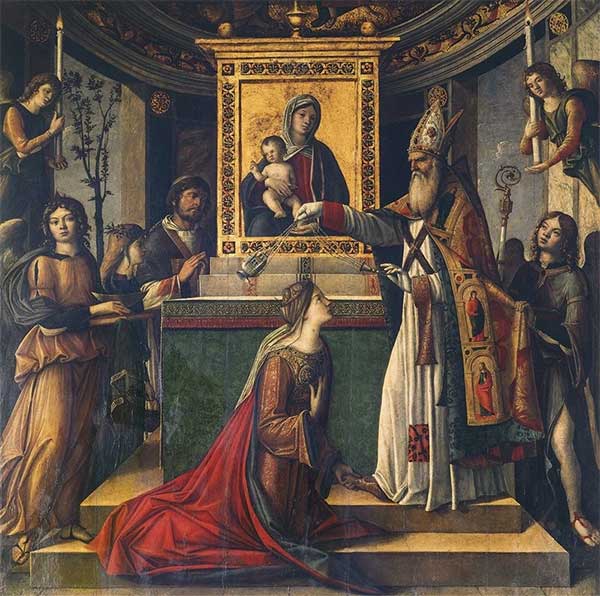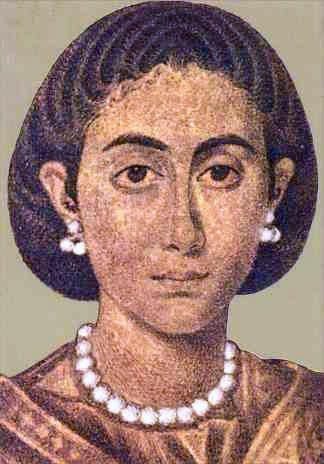The Roman historical records depict Galla Placidia as a treacherous woman, consorting with enemies, “bringing elephants to trample on her ancestors’ graves”, and steering the Western Roman Empire towards its demise.
However, recent in-depth studies of this most maligned queen have yielded contrary results. She not only endured a more tumultuous life than anyone else but was also a remarkable ruler.
The Age of Turmoil

Galla Placidia deserves recognition as a brilliant leader of the Western Roman Empire. (Image: Scala, Firenze).
Galla Placidia (? – 450) was the daughter of Emperor Theodosius I (347 – 395), the first and last ruler of the Theodosian Dynasty. As a child, the princess was betrothed to Eucherius, the son of General Stilicho at court.
Placidia grew up in the palace of Constantinople, Istanbul (now in Turkey). Starting from 388, after stabilizing the Eastern Roman Empire, Theodosius I led military campaigns to conquer the Western Roman Empire. In 394, he defeated the king of the western half, unifying Rome.
Before the division into Eastern and Western halves, Rome experienced a golden age. The city of Rome was a magnificent capital with grand palaces, 46,600 multi-story buildings, 1,800 castles, 856 public baths, 28 libraries, 10 massive aqueducts, 1,300 fountains, and an extensive road system, housing a population of millions.
However, everything changed after 200. War and turmoil nearly halved the population of Rome, leading to rampant lawlessness.
After unifying Rome, Theodosius I declared Christianity the state religion, allowing the suppression of all other religions, igniting the most brutal “cultural war”. Throughout 392, fanatical Christian mobs rampaged, destroying pagan temples, including the Temple of Olympia and the Statue of Zeus.
In 395, Emperor Theodosius I passed away. Rome was once again divided into two halves, with the East governed by Prince Arcadius and the West overseen by the adolescent Prince Honorius. Princess Placidia was ordered to leave Istanbul and move to Rome.
In 401, the Western Roman Emperor, Honorius, relocated to the port city of Ravenna, establishing his capital. This young king was notorious for his incompetence and vanity. In 404, Honorius claimed credit for General Stilicho’s accomplishments and held lavish celebrations on the Capitoline Hill. From that point on, relations between Honorius and his court deteriorated.
In 408, Honorius executed Stilicho and Eucherius out of suspicion. The king also ignored conflicts within the military between Roman soldiers and hired Gothic troops, disregarding the food supply agreement that Theodosius I had signed for an alliance with the Goths. Out of dissatisfaction, the contemporary Gothic king, Alaric I (370 – 410), led around 180,000 soldiers and civilians to besiege Rome.
The Princess as “Spoils of War”

Portrait of Emperor Alaric I, who made Placidia a “princess of spoils”.

Portrait of the “Gothic Queen” – Galla Placidia. (Image: Alamy – Wikipedia.org)
In early 410, Rome was densely populated with Gothic soldiers. For three months, they besieged 12 city gates and halted all transport on the Tiber River. Initially, the citizens of the city were not overly panicked, believing Emperor Honorius would intervene. Unexpectedly, Honorius did nothing.
After a prolonged siege, Rome fell into a state of famine. The citizens suffered so much that bodies piled up in the streets. Plagues also spread.
Princess Placidia, who had previously gone unnoticed, suddenly became the “brains of Rome” simply by residing within the city. Rumors such as “the princess colluding with the Goths,” “the princess inherited the cruelty of her father,” “the princess seeks to seize power”… spread widely.
Faced with the threat of starvation, the Roman Senate was forced to pay Emperor Alaric I 42 wagons of treasure. The Goths accepted this but did not withdraw, instead increasing their forces.
The only reason Alaric I hesitated to attack was his religious fervor. He feared that causing bloodshed in sacred Rome would bring divine punishment. Despite his strong military, he hoped to resolve the conflict through a favorable agreement for his people.
Contrary to Alaric I’s expectations, Emperor Honorius had deliberately abandoned Rome from the start. In the summer of 410, the Goths began to run out of supplies. With no other option, Alaric I commanded an attack.
Rome fell immediately. In just three days, the Goths searched and looted all the treasures of Rome. Princess Placidia, at this time in her twenties, was captured as a spoils of war.
After three days of looting, Alaric I led his troops and civilians along with the “living spoils” out of Rome. Upon hearing the news, Emperor Honorius breathed a sigh of relief, as the Goths had spared the capital, Ravenna.
The Empress of Unity
Just a few months after leaving Rome, Alaric I fell gravely ill and passed away. The Goths buried him in the southern regions of Rome, where they were encroaching. Athaulf (370 – 415), Alaric I’s brother-in-law, was unanimously chosen to ascend the throne.
Emperor Athaulf was known for his strategic mind, youth, and good looks. In January 414, he suddenly announced his marriage to the “spoils of war princess” – Placidia. Throughout the four years prior and the months leading up to his ascension, Athaulf had always overseen Placidia.
He had also humiliated Placidia upon her capture by making the princess sit in an uncovered wagon, announcing to all the places the Goths passed through that “this is the fallen princess of Rome.”
The Goths were nomadic like the Mongols, moving and pillaging continuously. Perhaps, after being “treated specially” for some time, Placidia was also regarded as a member of this “mobile nation.”
In ancient times, Romans had a prejudice that “Goths are barbarians.” According to historians’ conjectures, Placidia, having shared hardships with them for a long time, might have seen things differently.
Before the Gothic soldiers and civilians, Emperor Athaulf expressed his desire to marry Placidia because “she is nobler, more beautiful, and purer than any woman.” The Goths supported their king and organized the most extravagant wedding in Narbonne, Gaul (modern-day France), inviting numerous Roman and Gothic nobles to attend.
On the wedding day, Placidia wore a royal silk gown of the Goths while Athaulf donned Roman general’s armor. The king and queen declared the unification of Rome and the Goths, ending the war and nomadism, and establishing a peaceful nation for both Gothic and Roman citizens.
“I trust and wish to heed the advice of the queen, the wisest and most pious woman in the world,” Athaulf said. On their wedding day, the king gifted the queen 50 young men as bodyguards, each dressed in luxurious silk garments, carrying two large plates, one filled with gold and one with precious stones (all spoils from Rome). Not long after, Placidia gave birth to a prince, naming him after his grandfather – Theodosius.
Only a few months later, Theodosius died. In 415, Athaulf was assassinated. After several coups, Sigeric, the brother of General Sarus, who was likely the mastermind behind Athaulf’s assassination, ascended to the throne. Fearing repercussions, Sigeric killed all of Athaulf’s children (from a previous marriage).
Queen Placidia was spared execution because of her <em“Roman bloodline” (the Sarus and Sigeric brothers had cordial relations with Emperor Honorius), but she was still publicly ridiculed for a distance of 12 miles. Ultimately, Sigeric used her as a bargaining chip with Honorius, exchanging her for grain.

Queen Placidia and Emperor Athaulf ushered in a brief period of peace between the Goths and the Romans. (Image: Alamy)
The All-Powerful Regent
Upon returning to the Western Roman Empire, Placidia was forced by Emperor Honorius to marry the infamous, deceitful, and aged general – Constantius. The former Gothic queen vehemently opposed this, but could not change the situation.
Honorius held Constantius in high regard, even granting him the highest title of Augusta in 421.
Placidia had two children with Constantius, Honoria and Valentinian. Since Emperor Honorius had no offspring, Valentinian, Placidia’s son, naturally became the heir to the throne. From 417, two years before Valentinian’s birth, Placidia initiated the construction of the royal church in Ravenna – Santa Croce.
While the exterior of Santa Croce seemed rather ordinary, its interior was adorned magnificently. Quickly, this church attracted nobility from all over, helping Placidia build an extensive network of relationships and subtly consolidate her power.
Just a few months after being named Augusta, Constantius died of illness. Emperor Honorius, with his suspicious nature, once again turned against Placidia, exiling her from Ravenna.
Not long after expelling Placidia from Ravenna, Honorius fell ill and died at the age of 38. Before passing, the emperor bequeathed the throne to Joannes, a court official he trusted most.
Joannes did not possess the bloodline of the Theodosian dynasty, leading to public outcry. Immediately, Placidia mobilized her network of influence established during her time at Santa Croce, sending news and pleas for help to the Eastern Roman Empire, where her nephew, the son of her brother Arcadius – Emperor Theodosius II – was in power.
Theodosius II quickly dispatched a formidable army to the Western Roman Empire, assisting Placidia and her two young children in reclaiming the palace in Ravenna. Following this event, Placidia not only successfully placed her six-year-old son on the throne but also took over the title of Augusta of her late husband, becoming the regent.
For the next 10 years, Regent Placidia served as a steadfast support for the young Emperor Valentinian III. She established national laws, cared for the daily lives of the people, and continuously reformed the legal system to align with the changing times.
In 437, as Valentinian III came of age, Placidia stepped down from her regency but remained her son’s most reliable advisor. She was actively involved in religious affairs and earned the respect of theologians and popes.
Beyond Ravenna, Placidia also focused on Rome, allocating substantial budgets and assistance.




















































